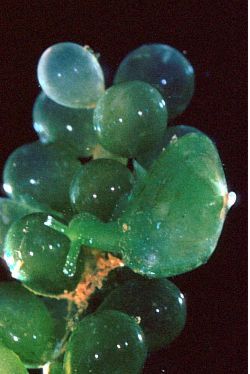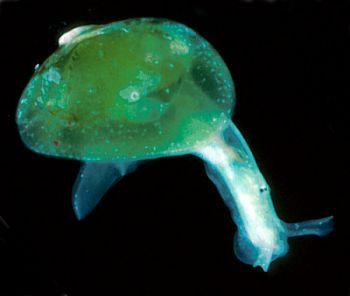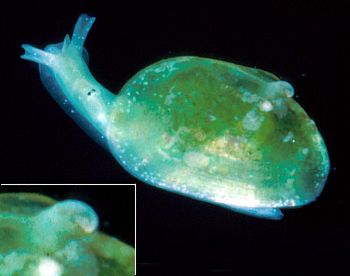
Tamanovalva babai
Burn, 1965
Order: SACOGLOSSA
Superfamily: OXYNOOIDEA
Family: Juliidae
DISTRIBUTION
Southeastern Australia from eastern South Australia and northern Tasmania to central Victoria.
PHOTO
TOP RIGHT: West Head, Flinders, Westernport Bay, Victoria, Australia. March 1986. Shell length 4mm approx. Inset showing protoconch. LOWER RIGHT: same animal from right side. LOWER LEFT: Goat Island Bch, Ulverstone, nthn Tasmania, Australia. On Caulerpa geminata. February 1984. Animal 9mm long (shell approx 5mm).
PHOTOS: Bill Rudman.
"Shell small, up to 8 mm in length, slender, trigonal, high anteriorly, narrowly rounded posteriorly, protoconch large and erect, colour yellowish. Body including shell mantle green, sometimes with cream patches along mantle margins and cream speckles on rhinophores; neck and rhinophores slender. This species ranges from south-eastern S.A. and northern Tas. to central Vic., from the lower intertidal to 3 m deep in bays and along the open coast. It occurs on and eats the green algae Caulerpa scalpelliformis, C. geminata and C. cactoides. It has been found only from mid-summer to autumn (January-May)." Description from Burn, 1989: 749.
Burn (1960) originally misidentified this species as Berthelinia typica (Gatliff & Gabriel) but he corrected his error in 1965 where he renamed this species, Tamanovalva babai, and redescribed Gatliff & Gabriel's species as Edenttellina typica. In Tamanovalva, the larval shell (protoconch) is very prominently displayed on the apex of the left shell valve (see Inset in upper photo). This clearly shows the gastropod (snail) relationships of these animals. The discovery of living animals of these strange 'bivalved gastropods' by Kawaguti & Baba (1960) in Japan caused a stir in the scientifc community and a rush to Caulerpa beds worldwide to find more species. Compare this species with the other two southeastern Australian species Midorigai australis and Edenttellina typica.
References:
• Burn, R.F. (1960) Australian bivalve gastropods. Nature, 187(4731): 44-46.
• Burn, R.F. (1965) Rediscovery and taxonomy of Edenttellina typica Gatliff and Gabriel. Nature, 206(4985): 735-736.
• Burn, R. (1989) Chapter 12. Opisthobranchs (Subclass Opisthobranchia). In: Shepherd, S.A. & Thomas, I.M. (Editors) Marine Invertebrates of Southern Australia Part 2, South Australian Government Printer, Adelaide.
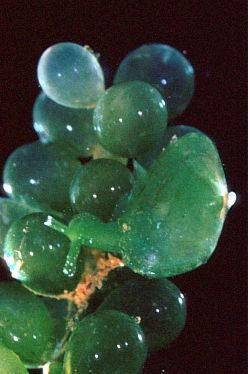
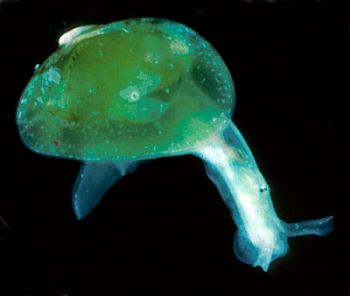
Rudman, W.B., 2001 (October 16) Tamanovalva babai Burn, 1965. [In] Sea Slug Forum. Australian Museum, Sydney. Available from http://www.seaslugforum.net/find/tamababa
Related messages
Tamanovalva babai from Victoria, Australia
October 20, 2001
From: John Chuk
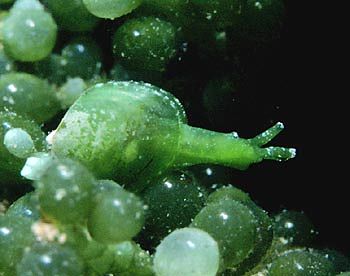
Dear Bill,
The recent messages and wonderful pictures of juliids from Hawaii have inspired me to scan some slides of what I think is Tamanovalva babai taken at Rickett's Point, Melbourne (Australia) in February 1999. The specimens were photographed close to shore in 2m of water. They have been observed in abundance at this site over the summer months for several years. Despite their abundance they are easy to miss as they are minute (with a maximum shell dimension of 4mm) and are very well camouflaged. The shell closely resembles, in shape and colour, the ramuli of the green alga, Caulerpa geminata, on which they are found.
The specimens are typically bright green in colour with a bivalved shell of the same colour. They are able to completely withdraw into the shell when threatened. The rhinophores are rolled and are white tipped. The eyespots are located on a small white-tipped, raised tubercle that is situated on the dorsum of the neck some distance behind the rhinophores. The neck and rhinophores have fine white spots on them.
The first image is an in situ lateral view of a specimen (7mm in length fully extended). This shot shows how thin and translucent the shell is as the outline of the neck can be seen through it. The second image is a view of the dorsum of a specimen that shows the bivalved shell. The third image is of rather poor quality but I have included it as it shows a specimen secreting a white solution on being aggravated by yours truly. Possibly a form of chemical defence? I was not tempted to taste it.
The bivalved sacoglossans are rather elegant and intriguing little animals. If any Victorian divers wish to see them then Rickett's point is the place to go. Find a bed of C. geminata and start searching!
Best wishes,
John.
jchuk@giant.net.au
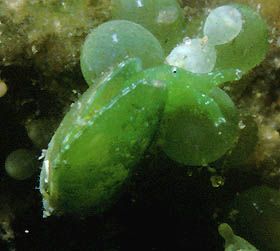
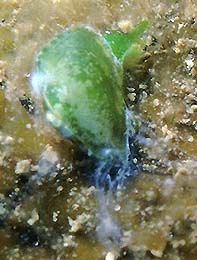
Dear John,
Yes these are Tamanovalva babai. Cory's Hawaiian photos also were the trigger I needed to prepare some material on the famous three species from south-eastern Australia, Tamanovalva babai, Midorigai australis, and Edenttellina typica.
Thanks for these photos and observations. The white secretions are defensive secretions that many sacoglossans can exude when stressed. At least in some species they appear to be recycled chemicals from their plant food.
Best wishes,
Bill Rudman
Tamanovalva babai from south-eastern Australia
October 20, 2001
From: Bill Rudman
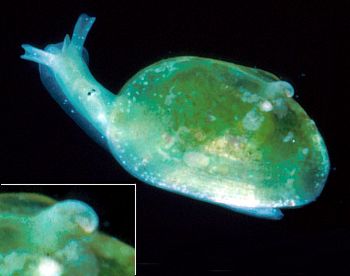
PHOTOS: TOP RIGHT: West Head, Flinders, Westernport Bay, Victoria, Australia. March 1986. Shell length 4mm approx. Inset showing protoconch. LOWER RIGHT: same animal from right side. LOWER LEFT: Goat Island Bch, Ulverstone, nthn Tasmania, Australia. On Caulerpa geminata. February 1984. Animal 9mm long (shell approx 5mm).
PHOTOS: Bill Rudman.
As I recently promised, here is some information on one of the bivalved sacoglossans, Tamanovalva babai, from south-eastern Australia.
Burn (1960) originally misidentified this species as Berthelinia typica (Gatliff & Gabriel) but he corrected his error in 1965 where he renamed this species, Tamanovalva babai, and redescribed Gatliff & Gabriel's species as Edenttellina typica. In Tamanovalva, the larval shell (protoconch) is very prominently displayed on the apex of the left shell valve (see Inset in upper photo). This clearly shows the gastropod (snail) relationships of these animals. The discovery of living animals of these strange 'bivalved gastropods' by Kawaguti & Baba (1960) in Japan caused a stir in the scientifc community and a rush to Caulerpa beds worldwide to find more species. Compare this species with the other two southeastern Australian species Midorigai australis and Edenttellina typica.
Reference:
• Burn, R.F. (1960) Australian bivalve gastropods. Nature, 187(4731): 44-46.
• Burn, R.F. (1965) Rediscovery and taxonomy of Edenttellina typica Gatliff and Gabriel. Nature, 206(4985): 735-736.
• Burn, R. (1989) Chapter 12. Opisthobranchs (Subclass Opisthobranchia). In: Shepherd, S.A. & Thomas, I.M. (Editors) Marine Invertebrates of Southern Australia Part 2, South Australian Government Printer, Adelaide.
Best wishes,
Bill Rudman
